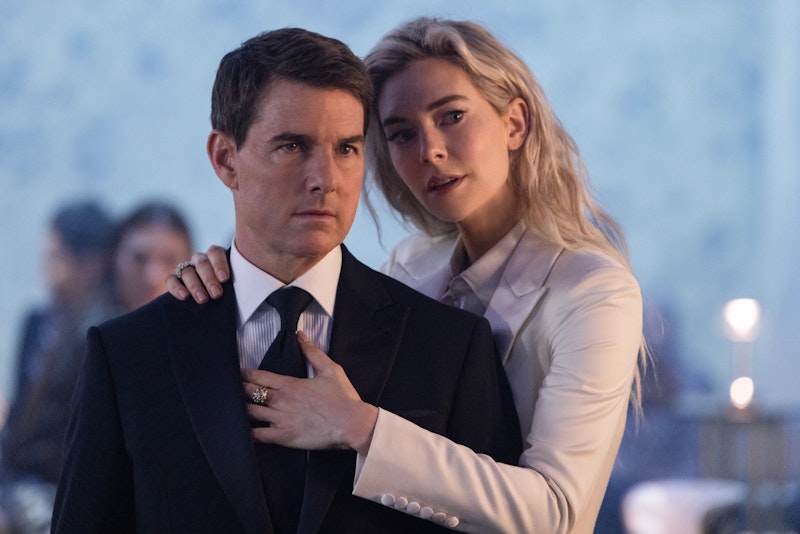For the second summer in a row, a Tom Cruise-starring sequel in a decades-old franchise has broken ground in action-adventure cinema, delivered superlative entertainment, and (most likely) rescued the summer box office. It’s Mission: Impossible—Dead Reckoning Part One, the seventh film in the franchise that started in 1996, and the best since Ghost Protocol in 2011. It’s got a strong top-to-bottom cast, a plot hook that’s of the moment, and five distinct action sequences.
Joining Cruise’s Ethan Hunt are a large coterie of characters, some from past installments and others new. Sidekicks Ving Rhames and Simon Pegg, neither of whom gets much work these days outside of this franchise, get some good moments, including an intense monologue Rhames delivers. Rebecca Ferguson’s Ilsa Faust is back, as is Vanessa Kirby’s arms dealer Alanna. And Henry Czerny returns as Eugene Kittridge, Cruise’s boss in the first movie and now the CIA director.
Among new characters, Hayley Atwell and Pom Klementieff, both Marvel veterans, make an impression, with Atwell a pickpocket who gets pulled into the action, and Klementieff as a silent assassin of uncertain loyalties. Shea Whigham is part of the movie’s best running gag, as a CIA man who chases Cruise for the entire movie, and always falls right behind.
But the main villain this time around is no character at all, but rather an evil A.I. known as “The Entity,” which has the ability to turn weapons systems against themselves and override all of every government’s security. In a twist that’s a sort-of obvious metaphor for the franchise’s love for practical effects, the characters must switch to old analog equipment. The plot is complicated: there’s a villain named Gabriel (Esai Morales) who “works for” the A.I. entity and also has a history with Ethan Hunt from before the events of the movie series. There’s some business about a two-part key which, if combined, can control the A.I., and most of the movie’s action entails the characters getting possession of those keys. And this scene has amazing action sequences. There’s a scene involving a meeting of the leaders of the U.S. intelligence community, and a sequence in an airport in which the disarming of a nuclear weapon is but an entertaining side quest.
The film’s centerpiece is a chase scene through the streets of Rome that goes on for about 15 minutes and has lots of moving parts. And the entirety of the third act is a battle on a moving train that has everything, from Cruise motorcycle-jumping onto the train Evel Knievel-style to a strategically-placed piano. While the Mission: Impossible series used to switch off directors every time, Christopher McQuarrie has directed the last three, and he and Cruise have turned this into a well-oiled machine. Dead Reckoning is neck-and-neck with John Wick Chapter IV as the best action-adventure movie of the year.
The two best action movies of the year have starred 61-year-old Tom Cruise and 58-year-old Keanu Reeves, which speaks to their enduring talents and a lack of rising new action stars. Cruise does look noticeably older than last year in Top Gun: Maverick—mostly because Top Gun sat on the shelf for nearly four years, while Dead Reckoning was finished more recently but he never seems too old. Especially now that we’ve seen Harrison Ford try to play an action hero at 80.
Mission: Impossible—Dead Reckoning Part One benefits from a direct comparison to Indiana Jones and the Dial of Destiny, and not only because of the comparative ages of its leading men. The style of the action is more clearly presented in Dead Reckoning and not only that, but both films have a sequence set on a train, a scene where two characters are handcuffed together, and a scene in which a MacGuffin object has to be combined from multiple parts. In every instance, the Mission: Impossible version is better.

